#inspired by symbolist art
Explore tagged Tumblr posts
Text
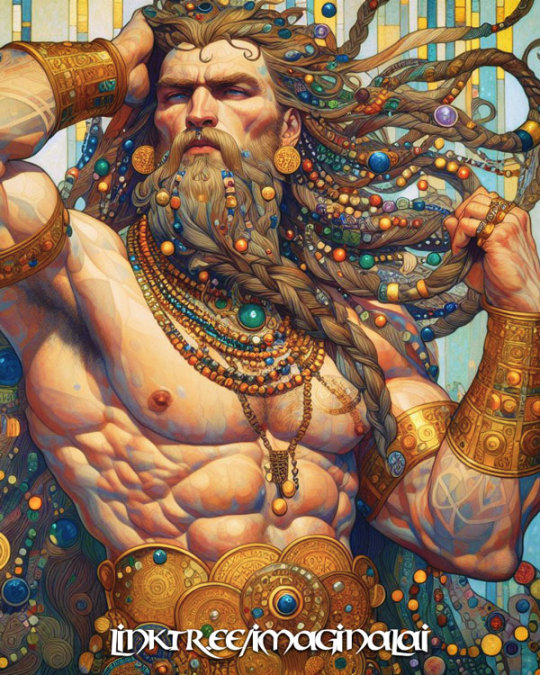
"Sigurd" (0001)
(The Viking Glamour Series)
#Norse#guardian#long haired man#long hair#muscular definition#abdominals#ai men#ai generated#ai artwork#ai art community#gay ai art#gay fantasy art#homoerotic#queerness#ai fashion#fashion illustration#bearded man#bearded hunk#male pinup#beefcake pinup#inspired by symbolist art#inspired by klimt#gay art#art direction#male form#male figure#male art#viking
76 notes
·
View notes
Text

the sad fate of louhi's youngest daughter
in the Kalevala, Louhi the witch is the queen of the underworld, or the far north. she has many beautiful daughters, and at one point Ilmarinen the smith god & Väinämöinen travel to demand Ilmarinen be allowed to marry one of the daughters to replace his deceased wife. Louhi offers her youngest; the daughter, however, spurns Ilmarinen, and in his rage he turns her into a bird - usually characterized as a seagull.
this painting is a response to that story, offering a reality where despite her transformation and subsequent demise, Louhi's youngest daughter is cared for, cradled, treasured. despite what change may unwillingly come, an image of acceptance and peace.
1/3 paintings created in residency at Kristiinankaupunki, June 2024.
#illustrators on tumblr#original art#kalevala#symbolist art#birds in art#mythology inspired art#mixed media art#mixed media painting#traditional media#traditional art#dorkbait art#my art
43 notes
·
View notes
Text

Arnold Böcklin (16 October 1827 – 16 January 1901)
Isle of the Dead (Third version, 1883)
#arnold bocklin#symbolist painting#symbolist art#symbolism#allegory#romanticism#art i like#amazing art#inspiring art#art academia#artists on tumblr#awesome art#mysticism#hidden meanings#hidden message#esoteric#esotericism#esoterismo#hidden history#metaphysical#great artist#magick#magic#art blog#art history#history of art#art#masterpiece#marvel#impressive
12 notes
·
View notes
Text

Red carnations Olga Suvorova (b. 1966, Russian)
Olga is the representative of the dynasty of Suvorov artists, which includes the three generations of St Petersburg artists: Olga’s parents, Natalia and Igor, and Olga’s daughter - Ekaterina. In 1998 Olga graduated from Saint-Petersburg Academy of Arts named after Ilya Repin, the workshop of A. Mylnikov. Olga has formed her authentic style of painting – historical costume portraits of personages in the style of various periods, such as the Renaissance and Rococo. Her work is reminiscent of the popular in the 20th century Saint Petersburg artistic movement ‘Mir Iskusstva’ (‘The World of Arts’) which was inspired with the art and culture of the 18th century. The artist constantly participates in exhibitions in Russia and abroad. Her works are found in private collections in England, America, Germany, China, Russia and other countries.
#dianthus#painting#figurative painting#figurative art#inspiration#symbolist art#woman artist#women in art#woman artwork#woman painter#russian art#olga suvorova
3 notes
·
View notes
Text
Dragonfly man

The butterfly told me,"If you can't fly high, fly free"...Jerico Silvers
#ink drawing#color pencil#freestyle#inspirational art#weird art#symbolist art#symbolism#art#artwork#colourful
0 notes
Text

Dear Tumblr community,
March is Women's History Month and I would like to feature at least two stories about women in plant science and botany. If you know of any historical figures you'd like to suggest for my upcoming essays, please let me know in the comments! I would like to feature less well known women in botany since there are often a few famous names that pop up on other science communication sites, whereas I would like to shine a light on experts forgotten by mainstream history.
Original AI art made by me and DALL E 3.
#katia plant scientist#botany#plant biology#plants#plant science#ai artwork#ai art#ai artist#ai generated#dall e 3#women in art#symbolist art#nature inspired#biophilia#women in science#womens history#womens history month#women in biology#history
0 notes
Text

Meet Wimper. I’m sketching him as one of the mayor characters of my picturebook. It’s a rough sketch I made when I woke up in the middle of the night. Let me know what you think of him?
#fantasy art#surealart#sketch#fantasydrawing#picturebook#illustrated book#symbolist art#art with meaning#fineart#instagram#illustration#dailyillustration#dailyinspiration#character illustration#contemporaryart#art 2023#thinking#designinspiration#inspiration#magic world#forest creature#copyright
0 notes
Text
Cross-posting an essay I wrote for my Patreon since the post is free and open to the public.

Hello everyone! I hope you're relaxing as best you can this holiday season. I recently went to see Miyazaki's latest Ghibli movie, The Boy and the Heron, and I had some thoughts about it. If you're into art historical allusions and gently cranky opinions, please enjoy. I've attached a downloadable PDF in the Patreon post if you'd prefer to read it that way. Apologies for the formatting of the endnotes! Patreon's text posting does not allow for superscripts, which means all my notations are in awkward parentheses. Please note that this writing contains some mild spoilers for The Boy and the Heron.

Hayao Miyazaki’s 2023 feature animated film The Boy and the Heron reads as an extended meditation on grief and legacy. The Master of a grand tower seeks a descendant to carry on his maddening duty, balancing toy blocks of magical stone upon which the entire fabric of his little pocket of reality rests. The world’s foundations are frail and fleeting, and can pass away into the cold void of space should he neglect to maintain this task. The Master’s desire to pass the torch undergirds much of the film’s narrative.

(Isle of the Dead. Arnold Böcklin. 1880. Oil on Canvas. Kunstmuseum. Basel, Switzerland.)
Arnold Böcklin, a Swiss Symbolist(1) painter, was born on October 16 in 1827, the same year the Swiss Evangelical Reformed Church bought a plot of land in Florence from the Grand Duke of Tuscany, Leopold II, that had long been used for the burials of Protestants around Florence. It is colloquially known as The English Cemetery, so called because it was the resting place of many Anglophones and Protestants around Tuscany, and Böcklin frequented this cemetery—his workshop was adjacent and his infant daughter Maria was buried there. In 1880, he drew inspiration from the cemetery, a lone plot of Protestant land among a sea of Catholic graveyards, and began to paint what would be the first of six images entitled Isle of the Dead. An oil on canvas piece, it depicts a moody little island mausoleum crowned with a gently swaying grove of cypresses, a type of tree common in European cemeteries and some of which are referred to as arborvitae. A figure on a boat, presumably Charon, ferries a soul toward the island and away from the viewer.
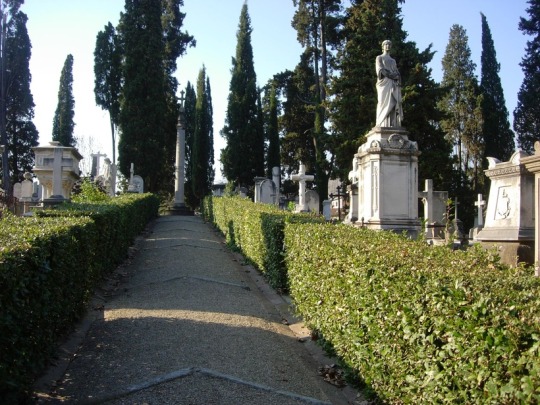
(Photo of The English Cemetery in Florence. Samuli Lintula. 2006.)
The Isle of the Dead paintings varied slightly from version to version, with figures and names added and removed to suit the needs of the time or the commissioner. The painting was glowingly referenced and remained fairly popular throughout the late 19th and early 20th centuries. The painting used to be inescapable in much of European popular culture. Professor Okulicz-Kozaryn, a philologist (someone with a deep interest in the ways language and cultural canons evolve)(2) observed that the painting, like many other works in its time, was itself iterative and became widely reiterated and referenced among its contemporaries. It became something like Romantic kitsch in the eyes of modern art critics, overwrought and excessively Byronic. I imagine Miyazaki might also resent a work of that level of manufactured ubiquity, as Miyazaki famously held Disney animated films in contempt (3). Miyazaki’s films are popularly aspirational to young animators and cartoonists, but gestures at imitation typically fall well short, often reducing Miyazaki’s weighty films to kitschy images of saccharine vibes and a lazy indulgence in a sort of empty magical domestic coziness. Being trapped in a realm of rote sentiment by an uncritical, unthoughtful viewership is its own Isle of Death.

(Still from The Boy and the Heron, 2023. Studio Ghibli.)
The Boy and the Heron follows a familiar narrative arc to many of Miyazaki’s other films: a child must journey through a magical and quietly menacing world in order to rescue their loved ones. This arc is an echo of Satsuki’s journey to find Mei in My Neighbor Totoro (1988) and Chihiro’s journey to rescue her parents Spirited Away (2001). To better understand Miyazaki’s fixation with this particular character journey, it can be instructive to watch Lev Atamanov’s 1957 animated film, The Snow Queen (4)(5), a beautifully realized take on Hans Christian Andersen’s 1844 children’s story (6)(7). Mahito’s journey continues in this tradition, as the boy travels into a painted world to rescue his new stepmother from a mysterious tower.
Throughout the film, Miyazaki visually references Isle of the Dead. Transported to a surreal world, Mahito initially awakens on a little green island with a gated mausoleum crowned with cypress trees. He is accosted by hungry pelicans before being rescued by a fisherwoman named Kiriko. After a day of catching and gutting fish, Mahito wakes up under the fisherwoman’s dining table, surrounded by kokeshi—little wooden dolls—in the shapes of the old women who run Mahito’s family’s rural household. Mahito is told they must not be touched, as the kokeshi are wards set up for his protection. There is a popular urban legend associated with the kokeshi wherein they act as stand-ins for victims of infanticide, though there seems to be very little available writing to support this legend. Still, it’s a neat little trick that Miyazaki pulls, placing a stray reference to a local legend of unverifiable provenance that persists in the popular imagination, like the effect of fairy stories passed on through oral retellings, continually remolded each new iteration.
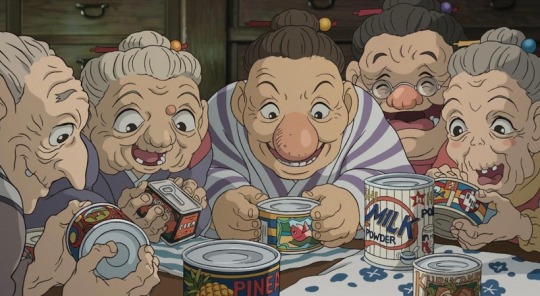
(Still from The Boy and the Heron, 2023. Studio Ghibli.)
Kiriko’s job in this strange landscape is to catch fish to nourish unborn spirits, the adorable floating warawara, before they can attempt to ascend on a journey into the world of the living. Their journey is thwarted by flocks of supernatural pelicans, who swarm the warawara and devour them. This seems to nod to the association of pelicans with death in mythologies around the world, especially in relationship to children (8). Miyazaki’s pelicans contemplate the passing of their generations as each successive generation seems to regress, their capacity to fulfill their roles steadily diminishing.

(Still from The Boy and the Heron, 2023. Studio Ghibli.)
As Mahito’s adventure continues, we find the landscapes changing away from Böcklin’s Isle of the Dead into more familiar Ghibli territories as we start to see spaces inspired by one of Studio Ghibli’s aesthetic mainstays, Naohisa Inoue and his explorations of the fantasy realms of Iblard. He might be most familiar to Ghibli enthusiasts as the background artists for the more fantastical elements of Whisper of the Heart (1995).

(Naohisa Inoue, for Iblard Jikan, 2007. Studio Ghibli.)
By the time we arrive at the climax of The Boy and the Heron, the fantasy island environment starts to resemble English takes on Italian gardens, the likes of which captivated illustrators and commercial artists of the early 20th century such as Maxfield Parrish. This appears to be a return to one of Böcklin’s later paintings, The Island of Life (1888), a somewhat tongue-in-cheek reaction to the overwhelming presence of Isle of the Dead in his life and career. The Island of Life depicts a little spot of land amid an ocean very like the one on which Isle of the Dead’s somber mausoleum is depicted, except this time the figures are lively and engaged with each other, the vegetation lush and colorful, replete with pink flowers and palm fronds.

(Island of Life. Arnold Böcklin. Oil on canvas. 1888. Kunstmuseum. Basel, Switzerland.)
In 2022, Russia’s State Hermitage Museum in Saint Petersburg acquired the sixth and final Isle of the Dead painting. In the last year of his life, Arnold Böcklin would paint this image in collaboration with his son Carlo Böcklin, himself an artist and an architect. Arnold Böcklin spent three years painting the same image three times over at the site of his infant daughter’s grave, trapped on the Isle of the Dead. By the time of his death in 1901 at age 74, Böcklin would be survived by only five of his fourteen children. That the final Isle of the Dead painting would be a collaboration between father and son seemed a little ironic considering Hayao Miyazaki’s reticence in passing on his own legacy. Like the old Master in The Boy and the Heron, Miyazaki finds himself with no true successors.
The Master of the Tower's beautiful islands of painted glass fade into nothing as Mahito, his only worthy descendant, departs to live his own life, fulfilling the thesis of Genzaburo Yoshino’s 1937 book How Do You Live?, published three years after Carlo Böcklin’s death. In evoking Yoshino and Böcklin’s works, Hayao Miyazaki’s The Boy and the Heron suggests that, like his character the Master, Miyazaki himself must make peace with the notion that he has no heirs to his legacy, and that those whom he wished to follow in his footsteps might be best served by finding their own paths.
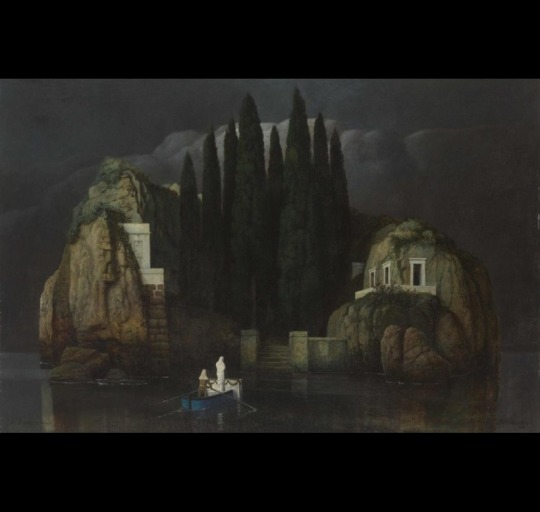
(Isle of the Dead. Arnold and Carlo Böcklin. Oil on canvas. 1901. The State Hermitage Museum. Saint Petersburg, Russia.)
INFORMAL ENDNOTES
1 - Symbolists are sort of tough to nail down. They were started as a literary movement to 1 distinguish themselves from the Decadents, but their manifesto was so vague that critics and academics fight about it to this day. The long and the short of it is that the Symbolists made generous use of a lot of metaphorical imagery in their work. They borrow a lot of icons from antiquity, echo the moody aesthetics from the Romantics, maintained an emphasis on figurative imagery more so than the Surrealists, and were only slightly more technically married to the trappings of traditionalist academic painters than Modernists and Impressionists. They're extremely vibes-forward.
2 - Okulicz-Kozaryn, Radosław. Predilection of Modernism for Variations. Ciulionis' Serenity among Different Developments of the Theme of Toteninsel. ACTA Academiae Artium Vilnensis 59. 2010. The article is incredibly cranky and very funny to read in parts. Contains a lot of observations I found to be helpful in placing Isle of the Dead within its context.
3 - "From my perspective, even if they are lightweight in nature, the more popular and common films still must be filled with a purity of emotion. There are few barriers to entry into these films-they will invite anyone in but the barriers to exit must be high and purifying. Films must also not be produced out of idle nervousness or boredom, or be used to recognise, emphasise, or amplify vulgarity. And in that context, I must say that I hate Disney's works. The barrier to both the entry and exit of Disney films is too low and too wide. To me, they show nothing but contempt for the audience." from Miyazaki's own writing in his collection of essays, Starting Point, published in 2014 from VIZ Media.
4 - You can watch the movie here in its original Russian with English closed captions here.
5 If you want to learn more about the making of Atamanoy's The Snow Queen, Animation Obsessive wrote a neat little article about it. It's a good overview, though I have to gently disagree with some of its conclusions about the irony of Miyazaki hating Disney and loving Snow Queen, which draws inspiration from Bambi. Feature film animation as we know it hadonly been around a few decades by 1957, and I find it specious, particularly as a comic artistand author, to see someone conflating an entire form with the character of its content, especially in the relative infancy of the form. But that's just one hot take. The rest of the essay is lovely.
6 - Miyazaki loves this movie. He blurbed it in a Japanese re-release of it in 2007.
7 - Julia Alekseyeva interprets Princess Mononoke as an iteration of Atamanov's The Snow Queen, arguing that San, the wolf princess, is Miyazaki's homage to Atamanoy's little robber girl character.
8 - Hart, George. The Routledge Dictionary of Egyptian Gods And Goddesses. Routledge Dictionaries. Abingdon, United Kingdom: Routledge. 2005.
#hayao miyazaki#the boy and the heron#how do you live#arnold böcklin#carlo böcklin#symbolists#symbolism#animation#the snow queen#lev atamanov#naohisa inoue#the endnotes are very very informal aksjlsksakjd#sorry to actual essayists
525 notes
·
View notes
Text
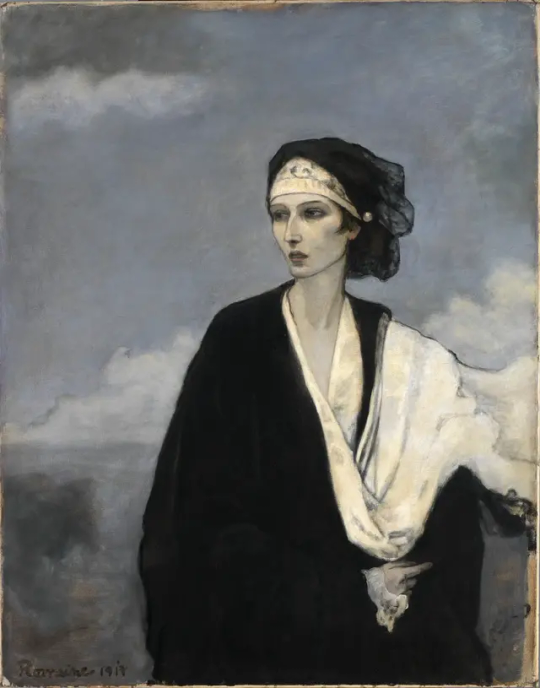
Romaine Brooks (1874-1970) "Ida Rubinstein" (1917) Oil on canvas Symbolist Located in the Smithsonian American Art Museum, Washington DC, United States Brooks met Russian dancer and arts patron Ida Rubinstein in Paris after Rubinstein's first performance as the title character in Gabriele D'Annunzio's play "The Martyrdom of St. Sebastian." Rubinstein was already well known for her refined beauty and expressive gestures; she secured her reputation as a daring performer by starring as the male saint in this boundary-pushing show that combined religious history, androgyny, and erotic narrative. In her autobiographical manuscript, "No Pleasant Memories," Brooks said the inspiration for this portrait came as the two women walked through the Bois de Boulogne on a cold winter morning.
#paintings#art#artwork#genre painting#female portrait#romaine brooks#oil on canvas#fine art#smithsonian american art museum#museum#art gallery#american artist#woman artist#women artists#female artists#history#portrait of a woman#clothing#clothes#1910s#early 1900s#early 20th century
168 notes
·
View notes
Text

“You’re scared. Because you know deep down, I’ll end up just like the others. Why ever get close, when you’ll just lose me in the end, right?”
HIII TUMBLR IM BACK WITH MORE FUN CRYPTIC SYMBOLISTIC ART (MY FAVORITE) went out of my usual comfort zone with this one (PEEP THE LINEART?? FINALLY FIGURED OUT HOW TO MAKE LINEART WORK FOR ME!! STILL WONT BE A THING I DO OFTEN THOUGH LMAOOO) BUT I HAD LOADS OF FUNWITH IT!!
basically the story here,
I got reminded of my like. over half a year old symbolistic intimacy kiibo piece (that instagram almost snipped me for bc artistic nudity is so scary or whatever over there) and was inspired to sort of make a shuichi parallel! kind of!!! cuz I’m still really fond of the kiibo centric piece!!
so obviously, like the other piece, this is in like. a dream scape in shuichis head, and that ghost-like kiibo is more of a reflection of his pushing AWAY of feelings, as opposed to curiousity and doubts, like the kiibo piece was. this killing game has taken everyone shuichi has gotten the chance to love, and crushed them in the palms of its hands, leaving him to weep. this ghosty kiibo is basically a manifestation of how badly he wants to pursue his feelings but he can’t bare to go through the same thing ALL over again.
oh! and heres that half year old kiibo symbolistic piece i was talking about! with its original caption too!, cuz I don’t think I ever got to sharing it here!! cw for non explicit nudity!!

"or are you just programmed to feel this way?"
the idea of this piece was centered around kiibo and his first experiences of feeling love and intimacy, how confused he'd be and how vivid it'd feel, I wanted to try and express that in a physical way, this almost ghost-like version of shuichi being a manifestation of all those feelings piled up, how he has no idea how to deal with them while simultaneously wanting so badly to pursue them, it's rly interesting to think about!!!
ANYWAYYSSS these two are so fucking fun for more intimate type symbolism idk. their relationship is so much more. complex when you look at all the layers to each side and each of their responses to things and etc etc EXPLODES IDK THOUGHTS AND BRAIN JUICES EVERYWHERE
#cw nudity#past the keep reading line !!#forgot I hadn’t shared the initial piece here yet pfhfh#ITS CRUTIAL#THEY MUST GO TOGETHER!!#CONTEXT MATTERS YADDA YADDA I LIKE DEEP RELATIONSHIP SAIIBO SYMBOLISM#saiibo#shuichi saihara#k1 b0#kiibo#keebo#danganronpa v3#danganronpa#drv3#danganronpa kiibo#danganronpa shuichi#saihara shuichi#danganronpa v3 killing harmony#danganronpa fanart#danganronpa art#danganronpa ships
131 notes
·
View notes
Text

"Sigurd" (0002)
(More of The Viking Glamour Series)
0001
#Norse#guardian#long haired man#long hair#muscular definition#abdominals#ai men#ai generated#ai artwork#ai art community#gay ai art#gay fantasy art#homoerotic#queerness#ai fashion#fashion illustration#bearded man#bearded hunk#male pinup#beefcake pinup#inspired by symbolist art#inspired by klimt#gay art#art direction#male figure#male art#male form#viking
27 notes
·
View notes
Photo

Lucien Lévy-Dhurmer (1865 - 1953) French "Nu bleu"
In 1896, Lévy-Dhurmer exhibited about twenty pastels and paintings at the Galerie Georges Petit under the name Lucien Lévy-Dhurmer.
His skill as a portrait painter was recognized and his depictions of the female form, although influenced by the art of Leonardo and the Pre-Raphaelites, were invested with mystery.
After 1901, Lévy-Dhurmer moved away from Symbolist content, and began to draw more inspiration from music.
155 notes
·
View notes
Text

“Trees are poems that the earth writes upon the sky.” — Kahlil Gabran
Trees, 1945 - Léon Spilliaert (Belgian, 1881-1946). Watercolour, gouache and India ink on paper, 61 x 44.5 cm.
Léon Spilliaert (also Leon Spilliaert; 28 July 1881 – 23 November 1946) was a Belgian draughtsman, illustrator, lithographer and painter. In his early career, he contributed to the development of symbolism in the visual arts in Belgium. He frequented the milieu of Belgian symbolist writers, of which Maurice Maeterlinck and Émile Verhaeren were the best known members. His work was inspired by visual and literary works by Edvard Munch, Fernand Khnopff, Edgar Allan Poe, Nietzsche and Lautréamont.
8 notes
·
View notes
Text
A lot of artists are familiar with archetypes, alchemy, occult topics, and mystical symbolism, intentionally weaving these elements into their art to convey deeper meaning. Alchemy isn't only about literal transmutation but also symbolic transformation—turning base materials (or the "base self") into something higher.
Artists like Hieronymus Bosch, Gustav Klimt, André Breton, and other surrealist/symbolists used alchemical symbolism to represent inner change and enlightenment.
Tim Burton is a big fan of arthouse cinema, especially Italian horror, which were movies hugely inspired by these themes.
It's no coincidence Beetlejuice appears to be an allegory for what alchemists referred to as Individuation / The Magnum Opus, the union of two opposites; a Chemical Wedding uniting the dead and the living. Betelgeuse and Lydia's union is a necessary step toward achieving this metaphorical completion, which is why marriage is a central theme of the story. It's the marriage between Spiritus and Corpus, the spirit (masculine) and the body (feminine).
Part 1 Part 2
14 notes
·
View notes
Text
An ‘Ism’ Overview - Symbolism vs. Surrealism
In the annals of art history, few movements have engendered as much controversy and debate as Symbolism and Surrealism. While both of these movements emerged in Europe during the late 19th and early 20th centuries, they represent fundamentally different approaches to the artistic process. In this essay, I will compare and contrast Symbolism and Surrealism, exploring the ways in which they differ in terms of their aims, methods, and outcomes.
Symbolism, which emerged in the late 19th century, is characterized by a fascination with the mystical, the esoteric, and the otherworldly. Its practitioners sought to represent the unseen and the intangible, using abstract forms and allegorical imagery to convey complex ideas and emotions. Symbolism was concerned with the spiritual and the transcendent, seeking to elevate the viewer's consciousness to a higher plane of understanding.
Surrealism, on the other hand, emerged in the early 20th century as a reaction to the trauma and chaos of World War I. Its practitioners sought to explore the realm of the unconscious, using dreamlike imagery and irrational juxtapositions to create a sense of disorientation and confusion. Surrealism was concerned with the psychological and the emotional, seeking to undermine the viewer's expectations and challenge their assumptions about reality.
While both Symbolism and Surrealism share a concern with the irrational and the fantastical, they differ in terms of their methods and techniques. Symbolist art is characterized by a highly stylized and decorative approach, with a focus on line, colour, and form. Symbolists often used allegorical or mythological figures to represent complex ideas or emotions, and their works often featured elaborate decorative motifs and patterns.
Surrealist art, by contrast, is characterized by a more spontaneous and free-form approach, with a focus on chance and accident. Surrealists often employed automatic drawing or other techniques to access the subconscious, creating images that were not preconceived or planned in advance. Surrealism often featured bizarre and fantastical creatures or settings, with an emphasis on the absurd and the grotesque.
In terms of their aims and outcomes, Symbolism and Surrealism also differ significantly. Symbolism sought to create a sense of transcendence and spiritual enlightenment, using art as a means of elevating the viewer's consciousness to a higher plane of understanding. Surrealism, by contrast, sought to challenge the viewer's assumptions and disrupt their sense of reality, using art as a means of subverting conventional modes of thought and perception.
In conclusion, Symbolism and Surrealism represent two fundamentally different approaches to the artistic process. While Symbolism is concerned with the spiritual and the transcendent, Surrealism is concerned with the psychological and the emotional. While Symbolist art is highly stylized and decorative, Surrealist art is more spontaneous and free-form. Ultimately, both movements have had a profound impact on the course of art history, and continue to inspire and influence artists today.
8 notes
·
View notes
Note
what got you so into the french revolution?
When I was in school for medieval art history, I did a lot of work on saints and their martyrdoms, particularly how the viewers of art depicting suffering imagined suffering, and how the agony/eroticism of those feelings induced a sort of memetic spiritual euphoria. Which means that I spent a ton of time looking at images of executions. I've seen them all: beheadings and sexymen shot full of arrows, saints barbecued or flayed or eaten by wild animals, criminals broken on the wheel -- all the classics. Or at least, I thought I had, until I encountered this triptych in my senior year of college:

This, by Belgian artist Antoine Wiertz, is The Visions of a Guillotined Head, painted in the late 1840s. Wiertz was a symbolist, and spent a great portion of his career drawn to the macabre, never more notably than on the occasion that inspired this painting.
In February 1848, two notable French criminals were due to be executed by the state. The guillotine was of course still in use as a method of capital punishment (and would be until the 1970s), and Wiertz was curious as to what a so-swiftly severed head felt and saw. He wasn't the first; since the guillotine's invention there had been legends of heads that blinked and blushed and tried to speak after separation. Luckily, Wiertz had a friend who was a hypnotist (as you do). Timed to the moment of the execution, he had his hypnotist pal put his soul "into rapport" with the dead criminal, and claimed that he entered the head itself as it fell.
He later recalled his experiences at some length in writing, but since we're talking about me, here is the important passage, dictated as he "felt" the horror of execution:
A horrible buzzing noise, the sound of the blade descending. The victim believes that he has been struck by lightning, not the axe. Astonishingly, the head lies under the scaffold and yet still believes it is above, still believes itself to be part of the body, and still waits for the blow that will cut it off. Horrible choking! No way to breathe. The asphyxia is appalling. It comes from an inhuman, supernatural hand, weighing down like a mountain on the head and neck. A cloud of fire passes before his eyes. Everything is red and glitters.
Now comes the moment when the executed man thinks he is stretching his cramped, trembling hands towards the dying head. It is the same instinct that drives us to press a hand against a gaping wound. And it occurs with the dreadful intention of setting the head back on the trunk, to preserve a little blood, a little life.
This fucked me up so bad.
I am well aware that consciousness after having your spinal cord severed is a done deal. I was aware of this in college. But there was something about this artist's act of imaginative empathy that compelled me, for the first time, to think about the guillotine in particular. About the mechanical wait, not being pushed off a drop or axed while kneeling, about being slid through on a board, of seeing the basket beneath you, already full of heads. Maybe even heads you know.
I imagined it so hard that I made myself sick and couldn't go to class for two days.
The reason I studied what I studied wasn't because I was ghoulish. In fact, I'm a little squeamish. It was because in the experience of pain, we are all deeply individualized, but entirely, helplessly human.
I laid in bed and thought about the small number of humans who I, an educated layman, knew had been guillotined: Marie Antoinette, obviously; Louis XVI; and (in what felt like black historical irony, given what I knew of his day job) Maximilian Robespierre.
It felt intrusive to have intimately imagined their last, most private moments, without really having any idea about them at all. Better to start at the end and work backwards, I thought. So I started reading.
Robespierre, decapitated by guillotine when he was thirty-six. That's the manner of death. How did he meet his death? In terrible pain, I learned. Why? Because he'd had half his jaw blown off the night before. Jesus, why? Because he'd (maybe probably) shot himself. Why?
It turns out, if you keep doing that, a piece at a time, for years, you can learn a lot about someone's life. And, relatedly, in long and branching paths, you can find your way into every nook and cranny of what burned through France at the end of the 18th century.
#aren't you glad you asked#hey emily why were you so obsessed with executions and the horror of suspended pain in the first place?#well yes you see I was raised evangelical and read foxe's book of martyrs at the tender age of eight and it drilled a channel into my brain#hey emily did something happen to you in college that made you hyperfocus on the gossamer threads between life and death?#would you look at the time!!!!#anyway this was probably not the answer you expected but it is what it is#I have seen the past and I foresee the future
94 notes
·
View notes